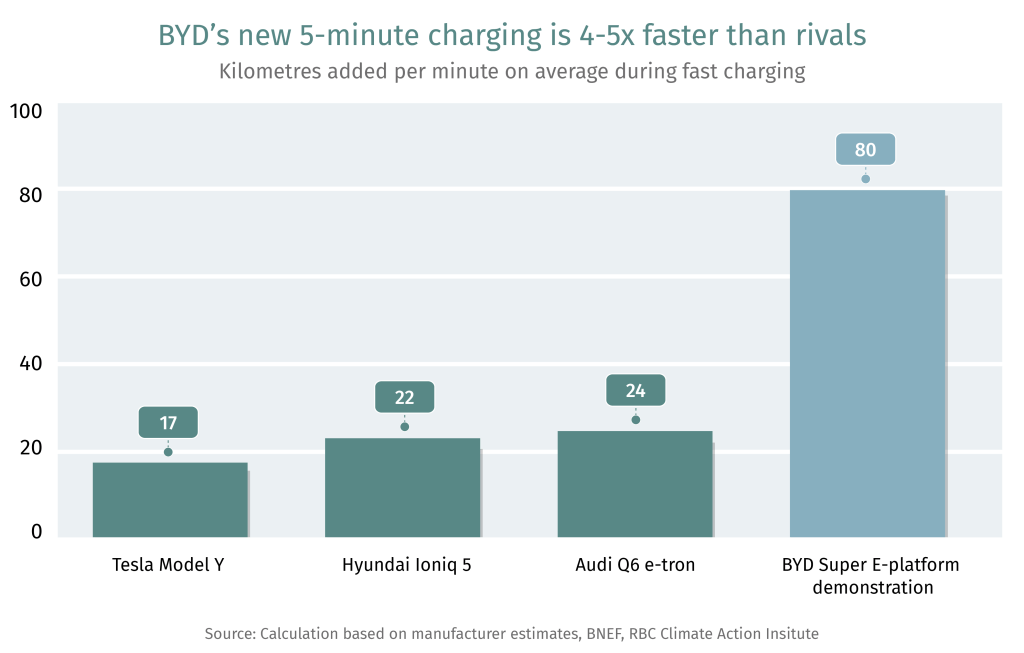The super-charging revolution is here.
Recent demonstrations by Chinese electric vehicle (EV) giants BYD and CATL of batteries that can be charged in five minutes—up to five times faster than rivals—and with a range of 520 kilometres, has made many sit up and take notice.
Could this super-charging revolution be the game changer that will pave the way for greater EV adoption in Canada, and elsewhere? Equally crucial: can electricity grids handle the increased load demand if this technology were to reach Canadian shores in the next few years?
A game changer?
A five-minute charge has the potential to address two of the top three concerns that consumers often cite when considering EVs: range anxiety and access to public charging stations (the third being affordability). According to a JD Power survey in 2024, 68% of Canadians were anxious about running out of EV battery while on the road.The inconvenience of waiting in line at public charging stations and long charge times—on average 30 minutes—have been an issue for up to half of EV drivers, a survey shows. A five-minute charge battery with extended range tackles these issues head on and entice would-be owners to finally take the EV plunge.

The 3 big grid challenges facing 5-minute charging
Here’s how the quick-charge revolution could impact Canada’s grids:It’s a massive draw on the grid:
-
It’s a massive draw on the grid: Unlike traditional charging that’s spread over hours, fast charging delivers high-intensity power spike that grids might not be designed to handle. An average EV with a battery of 80 kWh would require around 1,000 kW power to fully charge in minutes. That’s enough electricity to power 800 homes for the same amount time, and adds significant load to the grid, especially if charging takes place during peak hours.
-
Grid expansion is already facing once-in-a-generation challenge. Expanding local distribution networks, modernizing local substations, and improving interconnections to accommodate localized demand surges are the biggest challenges posed by super-charging. Distribution lines will also need to grow by another 55,000-85,000 kilometres by 2030—requiring a build-out that’s 30%-100% faster than the current pace.
-
Future-proofing would require a decentralized grid: Fast, localized spikes in demand require more than just expansion of centralized grid assets. They also require the addition of decentralized distributed energy resources (DERs), such as micro-grids and residential solar, and greater grid digitization. Infrastructure modernization can also transform DERs into virtual power plants during periods of peak demand.
Farhad Panahov is an economist with the RBC Climate Action Institute.
This article is intended as general information only and is not to be relied upon as constituting legal, financial or other professional advice. The reader is solely liable for any use of the information contained in this document and Royal Bank of Canada (“RBC”) nor any of its affiliates nor any of their respective directors, officers, employees or agents shall be held responsible for any direct or indirect damages arising from the use of this document by the reader. A professional advisor should be consulted regarding your specific situation. Information presented is believed to be factual and up-to-date but we do not guarantee its accuracy and it should not be regarded as a complete analysis of the subjects discussed. All expressions of opinion reflect the judgment of the authors as of the date of publication and are subject to change. No endorsement of any third parties or their advice, opinions, information, products or services is expressly given or implied by Royal Bank of Canada or any of its affiliates.
This document may contain forward-looking statements within the meaning of certain securities laws, which are subject to RBC’s caution regarding forward-looking statements. ESG (including climate) metrics, data and other information contained on this website are or may be based on assumptions, estimates and judgements. For cautionary statements relating to the information on this website, refer to the “Caution regarding forward-looking statements” and the “Important notice regarding this document” sections in our latest climate report or sustainability report, available at: https://www.rbc.com/our-impact/sustainability-reporting/index.html. Except as required by law, none of RBC nor any of its affiliates undertake to update any information in this document.


